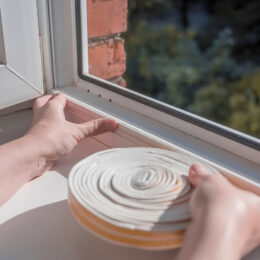My black asphalt shingle roof needs to be replaced. I want to install a new roof that will last longer and help keep my home cooler during hot summer afternoons. What type of roof do you recommend?

This is a 1×2-foot aluminum-roofing panel with a heat reflecting buckskin colored finish. Notice the inter-locking flanges on the side and top.
From the standpoint of a long life and keeping your home cooler, a black asphalt shingle roof is probably the worst option. The dark color absorbs much of the sun’s heat, which not only makes your home hotter and drives up your air-conditioning costs, but hastens the degradation of the shingle material itself.
A black shingle can easily reach 150 degrees F in the hot afternoon sun. The heavy mass of asphalt shingles also stores the heat and radiates it down into your home well into the evening.
Even if you have adequate insulation on the attic floor, the radiant heat from the hot roof easily passes through to room ceilings. Standard thermal insulation, such as batts and blown-in fiberglass or rock wool and cellulose, are most effective for blocking conductive heat transfer, but less so for radiant heat from a hot roof.
The two most common roofing materials for homes are shingles and metal. White shingles can be fairly energy efficient and effective for reflecting much of the sun’s heat. Some white shingles even qualified for the former Federal energy tax credit. Keep in mind, it takes very little color tint before shingles start to absorb heat, so white is the most efficient option.
Metal roofing can cost twice as much as shingles, but many types have lifetime warranties, and they can reflect the majority of the sun’s heat. Aluminum and steel are the two most common and reasonably priced materials. Copper is attractive and durable. It is quite expensive, but the natural aged patina color is beautiful and it absorbs heat well.
I installed an aluminum simulated shake roof on my own home five years ago while the energy tax credit was in effect. My roof consists of 1×2-ft. interlocking panels with a special heat-reflecting paint coating. The panels are made of recycled aluminum from soda pop cans and are formed to look like cedar shakes.
Aluminum is a particularly efficient roofing material because the underside surface of the roofing panels is bare. With a low emissivity rating, it does not allow the heat from the hot metal to pass through to the roofing lumber and insulation below. When selecting an aluminum roof, it is important that its contour provides an air gap over the sheathing for its low-emissivity properties to be effective. A simulated clay tile aluminum roof is also very effective with the many air gaps under it.
After my aluminum roof was installed, the second floor bedrooms stayed much cooler during summer afternoons. The only drawback to an aluminum metal roof is you must be careful walking on it and stepping on the high shake’s edges so it is not damaged. During winter, snow sometimes slides off in large sheets and crushes shrubs and blocks the garage door. Snow stops can be glued to the roof to stop this, but they may also catch leaves and debris from nearby trees.
Painted steel roofs are also available in many colors and simulated contours. The steel is treated with many layers of corrosion-resistant coatings so rust is not a problem. Steel roofs with an aluminum-alloy coating are particularly durable. Steel is very strong, so there are fewer problems with walking on it.
Since your old shingles are likely cracked with curled edges, they would have to be torn off before new shingles are installed. Most metal roofs, because of their rigidity, can be installed over existing shingles no matter what their condition. This saves the cost (often about $1,000) of tearing off the old shingles.
Whether you choose white shingles or a metal roof with heat-reflecting paint, also consider installing an attic ridge vent. When replacing a roof, adding a ridge vent is a minor additional expense. If you install, make sure the soffit vents are not blocked by attic insulation. Even with the metal roof, adequate attic ventilation is needed for both summer and winter energy efficiency.
James Dulley is a nationally syndicated engineering consultant based in Cincinnati. If you have a question about energy use or energy-efficient products, send it to: James Dulley, Electric Consumer, 6906 Royalgreen Drive, Cincinnati, OH 45244; or visit www.dulley.com.



